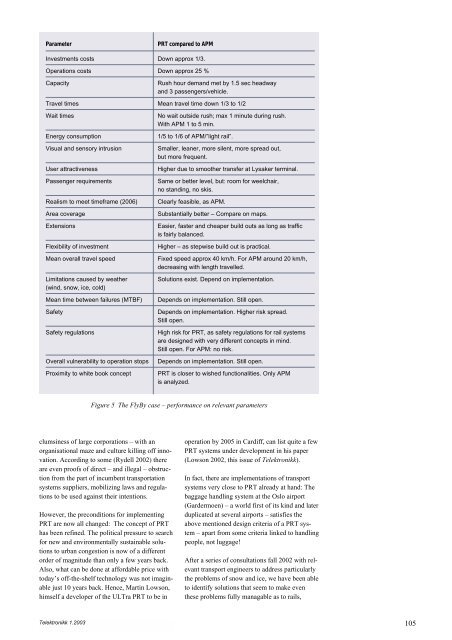Intelligent Transport Systems - Telenor
Intelligent Transport Systems - Telenor
Intelligent Transport Systems - Telenor
You also want an ePaper? Increase the reach of your titles
YUMPU automatically turns print PDFs into web optimized ePapers that Google loves.
Parameter PRT compared to APM<br />
Investments costs Down approx 1/3.<br />
Operations costs Down approx 25 %<br />
Capacity Rush hour demand met by 1.5 sec headway<br />
and 3 passengers/vehicle.<br />
Travel times Mean travel time down 1/3 to 1/2<br />
Wait times No wait outside rush; max 1 minute during rush.<br />
With APM 1 to 5 min.<br />
Energy consumption 1/5 to 1/6 of APM/”light rail”.<br />
Visual and sensory intrusion Smaller, leaner, more silent, more spread out,<br />
but more frequent.<br />
User attractiveness Higher due to smoother transfer at Lysaker terminal.<br />
Passenger requirements Same or better level, but: room for weelchair,<br />
no standing, no skis.<br />
Realism to meet timeframe (2006) Clearly feasible, as APM.<br />
Area coverage Substantially better – Compare on maps.<br />
Extensions Easier, faster and cheaper build outs as long as traffic<br />
is fairly balanced.<br />
Flexibility of investment Higher – as stepwise build out is practical.<br />
Mean overall travel speed Fixed speed approx 40 km/h. For APM around 20 km/h,<br />
decreasing with length travelled.<br />
Limitations caused by weather Solutions exist. Depend on implementation.<br />
(wind, snow, ice, cold)<br />
Mean time between failures (MTBF) Depends on implementation. Still open.<br />
Safety Depends on implementation. Higher risk spread.<br />
Still open.<br />
Safety regulations High risk for PRT, as safety regulations for rail systems<br />
are designed with very different concepts in mind.<br />
Still open. For APM: no risk.<br />
Overall vulnerability to operation stops Depends on implementation. Still open.<br />
Proximity to white book concept PRT is closer to wished functionalities. Only APM<br />
is analyzed.<br />
clumsiness of large corporations – with an<br />
organisational maze and culture killing off innovation.<br />
According to some (Rydell 2002) there<br />
are even proofs of direct – and illegal – obstruction<br />
from the part of incumbent transportation<br />
systems suppliers, mobilizing laws and regulations<br />
to be used against their intentions.<br />
However, the preconditions for implementing<br />
PRT are now all changed: The concept of PRT<br />
has been refined. The political pressure to search<br />
for new and environmentally sustainable solutions<br />
to urban congestion is now of a different<br />
order of magnitude than only a few years back.<br />
Also, what can be done at affordable price with<br />
today’s off-the-shelf technology was not imaginable<br />
just 10 years back. Hence, Martin Lowson,<br />
himself a developer of the ULTra PRT to be in<br />
Telektronikk 1.2003<br />
Figure 5 The FlyBy case – performance on relevant parameters<br />
operation by 2005 in Cardiff, can list quite a few<br />
PRT systems under development in his paper<br />
(Lowson 2002, this issue of Telektronikk).<br />
In fact, there are implementations of transport<br />
systems very close to PRT already at hand: The<br />
baggage handling system at the Oslo airport<br />
(Gardermoen) – a world first of its kind and later<br />
duplicated at several airports – satisfies the<br />
above mentioned design criteria of a PRT system<br />
– apart from some criteria linked to handling<br />
people, not luggage!<br />
After a series of consultations fall 2002 with relevant<br />
transport engineers to address particularly<br />
the problems of snow and ice, we have been able<br />
to identify solutions that seem to make even<br />
these problems fully managable as to rails,<br />
105
















